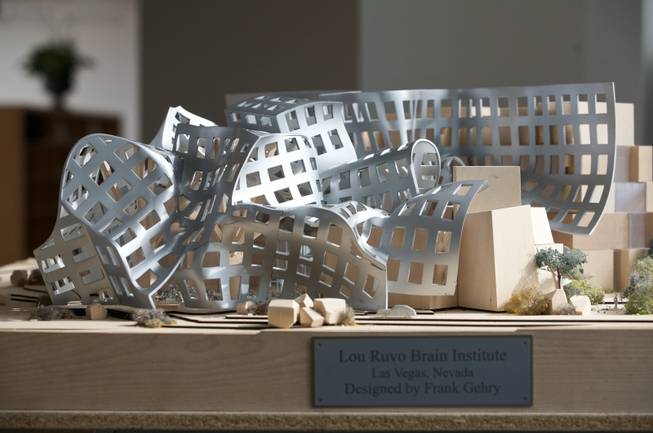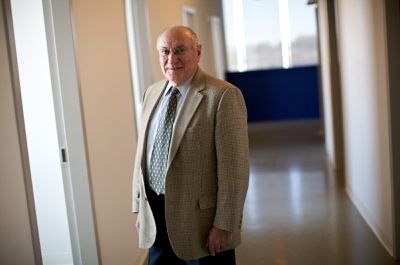
A model of Frank Gehry’s Cleveland Clinic Lou Ruvo Center for Brain Health is displayed in the top floor offices at the Las Vegas building, seen on Monday, Feb. 9, 2009.
Friday, Feb. 27, 2009 | 7:23 p.m.
Sun Archives
- Ruvo's dream becomes real (2-17-2009)
- Ruvo's mission is bold, driven by love (2-17-2009)
- Gehry's design elevates awareness of Alzheimer's disease, research (2-17-2009)
- In Cleveland, patients are priority (2-17-2009)
- Aiming to revolutionize dementia research (1-7-2009)
When Dr. Zaven Khachaturian says something looks like a brain, it looks like a brain. The man knows his brains, and the Lou Ruvo Brain Institute, from certain angles, looks like a brain.
“When (architect) Frank Gehry first showed me the model, I suggested perhaps he had inadvertently modeled it after the brain, in that it is a complex organ and has an undulating surface, and also because it has two parts, two hemispheres,” Khachaturian said during an interview for this week’s installment of “Our Metropolis,” the radio show I host for KUNV 91.5-FM (click here for our 30-minute discussion). “Since then, the idea of it relating to the brain has taken hold.”
But it wasn’t originally intended to look like a brain. Khachaturian, one of the world’s foremost neurologists and the president and CEO of the newly renamed Cleveland Clinic Lou Ruvo Center for Brain Health, said the original concept for design of the facility was multifaceted. Buildings stacked atop each other, often found in Moroccan villages, inspired the clinical space. The activity center in the 67,000-square-foot facility was to evoke images of sand dunes, and also the sense of a folding blanket enveloping an infant or someone who has been rendered disabled.
But those notions have given way to the brain theory. “A lot of people rewrite history,” Khachaturian said, chuckling.
Though he says galas are “not my thing,” the architect of the center's medical programs will be on hand tonight at the Keep Memory Alive fundraising gala at the Bellagio. While the energy of the room will be focused onstage, with the reunion of Siegfried & Roy for a 12-minute performance, Khachaturian will lay low. By nature, he is far more interested in medical innovations than red carpet walks, or even building designs. But he did embrace the celebrity of Gehry when Larry Ruvo told him the iconic architect would design the facility.
“Invariably, we like to create edifices to immortalize a person, and that can eat up a tremendous amount of resources,” Khachaturian said. “… My attitude had always been that the emphasis should be about putting the resources into the medical programs rather than into bricks and mortar. But when I met Larry and Frank Gehry, I had a completely different attitude, diametrically opposite to my previous position. … I felt that having an architectural icon was an important statement to be made in the field of degenerative brain disorders, which was not getting enough attention nationally. Having a world famous architect put his name onto a building dedicated to neurodegenerative diseases, and someone like Larry staking his fame and fortune to this, was an important statement. I feel that the building has an enormous symbolic value to the world. People see in it what they want to see.”
Khachaturian also talked of one of the more important components of the facility’s treatment programs, modifying the homes of those afflicted to create “smart homes” to help keep patients in familiar living surroundings. It can be wrenching to try to convince family members who are suffering from neurodegenerative diseases that they have to be moved out of houses they may have been living in for decades. “It’s a very, very important issue. What can we do to reduce the burden that families face? Think of the people involved, too -- older people do not like to be moved from their homes, their neighborhoods, into any type of facility.”
The Ruvo clinic will work to develop technology that can be brought into the home to monitor movement and activity (to make sure the pot on the stove is not accidentally left on for hours, for example) of older people, and to remind patients to take medicine as scheduled. “We will be testing communities where this type of technology can be brought into the home to make it easier to manage and take care of individuals.” Eventually, Khachaturian says, robots might be brought into the home to assist in the care of those suffering. It all sounds very “Jetsons,” but as Khachaturian will tell you, nothing is too ambitious for this project, where dazzling architecture meets the most advanced medical science in downtown Las Vegas.



Join the Discussion:
Check this out for a full explanation of our conversion to the LiveFyre commenting system and instructions on how to sign up for an account.
Full comments policy